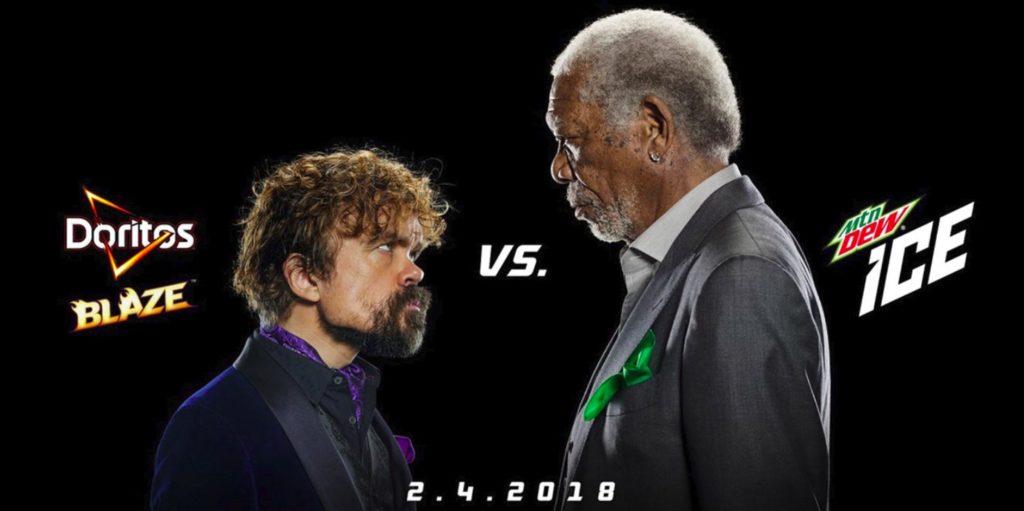This post is the second in our Content Marketing 101 series. Subscribe to our blog to get more updates delivered right to your inbox.
Welcome to Part 2 of our Content Marketing series. Now that we’ve defined Content Marketing in Part 1, let’s take a deeper dive with a collection of some of the most important stats shaping the practice today.
To help as you scroll through all these numbers, we’ve organized the stats into a few main categories:
- Digital media audience
- Content Marketing adoption
- Content Marketing management
- Content Marketing successes
- Content Marketing best practices
- Content Marketing challenges
- Content Marketing measurement
Related – [Infographic]: Top 10 Reasons Why Your Brand Needs Content Marketing
The Ultimate Collection of Content Marketing Statistics
Digital media audience
When you factor in the number of users, the time spent online and the ability to target specific audiences, there’s no better medium than the internet if you’re looking to get your brand’s message in front of as many potential customers as possible.
No. 1: There are 3.8 billion internet users around the world, and that number continues to increase every day.
(Source: internet live stats)
No. 2: In 2018, U.S. adults will spend more than six hours a day with digital media – that’s more than TV, Radio or Print.
Average time spent per day with major media by U.S adults

(Source: eMarketer)
No. 3: Every minute, on average, internet users publish 1,440 blog posts on WordPress, share 3.3 million pieces of content on Facebook, upload 500 hours of video on YouTube, send 448,000 new tweets on Twitter and post 65,972 new photos on Instagram.
(Source: Smart Insights)
Content Marketing adoption
Even with an internet audience that’s approaching 3.9 billion (just guessing another 100 million people or so joined the club in the time it took to write the last three paragraphs), brands will have a tough time reaching consumers unless their message resonates with audiences. In this cluttered landscape, Content Marketing offers brands a great opportunity to stand out with messaging that’s designed to educate, inform and entertain audiences, rather than interrupt them.
No. 4: 86 percent of B2C brands use Content Marketing.
(Source: Content Marketing Institute – B2C Content Marketing)
No. 5: 60 percent of B2C marketers say their organizations are extremely/very committed to content marketing.
(Source: Content Marketing Institute – B2C Content Marketing)
No. 6: Almost two-thirds of brands describe their Content Marketing maturity level as in the “first steps,” “young” or “adolescent” stage.
Content Marketing maturity level for B2C brands

(Source: Content Marketing Institute – B2C Content Marketing)
No. 7: 92 percent of content marketers surveyed say their organization views content as a business asset (i.e., a process with a direct investment and a goal of increasing value over time).
(Source: Content Marketing Institute – 2017 Content Management & Strategy Survey)
No. 8: 75 percent of companies say they plan to increase their Content Marketing investment.
(Source: Curata – 2016 Content Marketing Staffing & Tactics Study)
No. 9: 43 percent of companies say they plan to increase their Content Marketing staff levels.
(Source: Curata – 2016 Content Marketing Staffing & Tactics Study)
No. 10: In 2017, 51 percent of companies had an executive in their organization responsible for their Content Marketing strategy (vs. 42 percent in 2016).
(Source: Curata – 2016 Content Marketing Staffing & Tactics Study)
No. 11: 65 percent of U.S. creative professionals saw an increase in the amount of content they’ve created in the past 5 years.
(Source: eMarketer via Adobe)
Content Marketing management
Many brands are still getting the hang of Content Marketing, especially those managing the efforts in-house.
No. 12: Despite 86 percent of B2C brands reporting they’re actively using Content Marketing, only 46 percent of marketers have a documented strategy for managing content as a business asset.
(Source: Content Marketing Institute – B2C Content Marketing)
No. 13: There are a variety of tactics and strategies brands need to implement to achieve a robust Content Marketing strategy. Even though a lot of brands have at least some Content Marketing structures in place, it varies by item.
Content Marketing structures in place
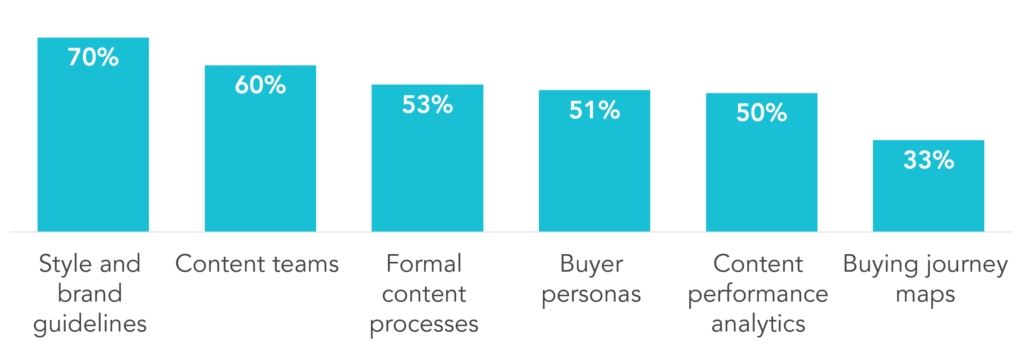
(Source: Content Marketing Institute – 2017 Content Management & Strategy Survey)
No. 14: 46 percent of content marketers always or frequently prioritize providing the right content to the right person at the right time. Across the board, brands have varying success in terms of meeting important Content Marketing conditions.
Frequency in which content-related processes meet various conditions
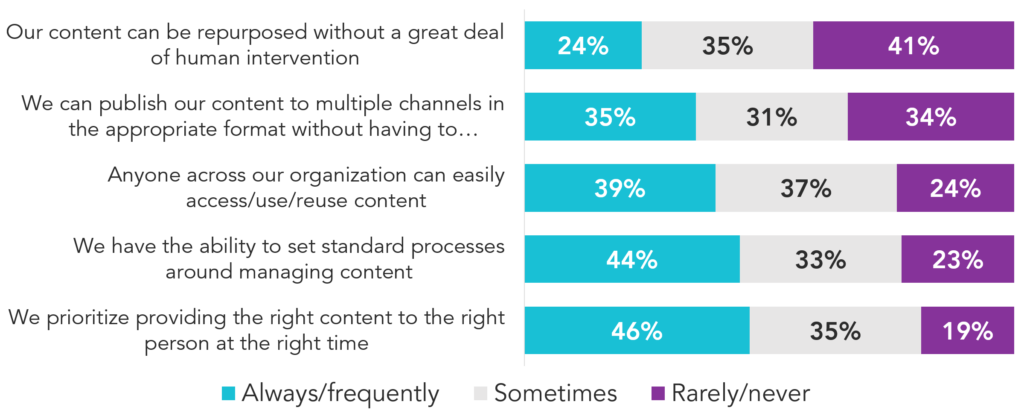
(Source: Content Marketing Institute – 2017 Content Management & Strategy Survey)
Content Marketing successes
As brands continue to grow their Content Marketing efforts, many are starting to reap the rewards of those efforts. Content Marketing is like a snowball rolling down a hill. As campaigns pick up speed, increased content output leads to a greater return on investment in terms of meeting business goals. The number of content pieces isn’t the only factor, though, brands are also seeing success with longer content pieces.
No. 15: 66 percent of brands are more successful at Content Marketing now than a year ago.
(Source: Content Marketing Institute – B2C Content Marketing)
No. 16: 75 percent of successful B2C marketers cited a change in strategy as the No. 1 factor for increased Content Marketing success over the past year.
(Source: Content Marketing Institute – B2C Content Marketing)
No. 17: 74 percent of companies have experienced an increase in lead quality because of Content Marketing.
Areas that brands have reported improved results from Content Marketing

(Source: Curata – 2016 Content Marketing Staffing & Tactics Study)
No. 18: Brands that publish more than 16 blog posts per month receive 4.5 times more leads than brands that publish 0 – 4 posts a month.
(Source: HubSpot)
No. 19: The length of a typical blog post increased from 808 words in 2014 to 1,142 words in 2017.
(Source: Orbit Media Solutions)
No. 20: 56 percent of bloggers report strong results from articles with more than 2,000 words compared to 20 percent from articles with less than 500 words.
Bloggers who report strong results based on word count
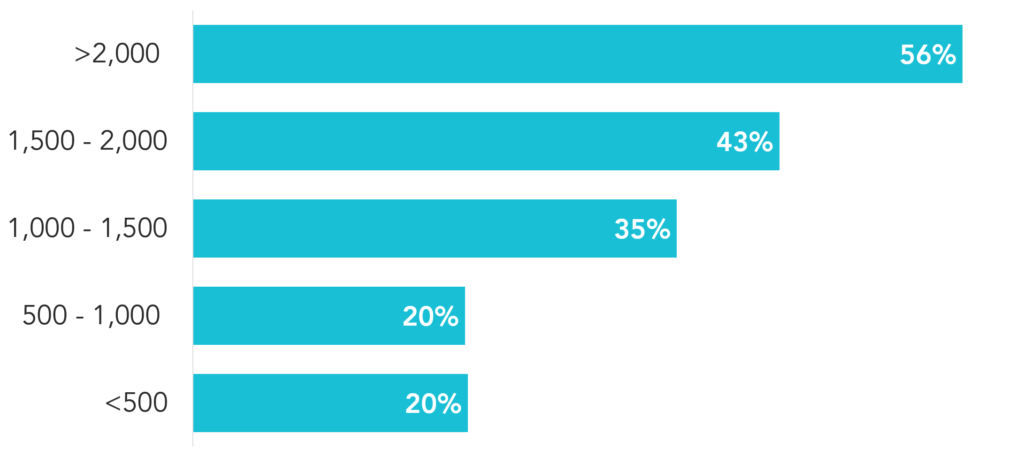
(Source: Orbit Media Solutions)
Content Marketing best practices
As more brands continue to implement campaigns and practitioners hone their craft, Content Marketing strategy has continued to evolve. Today’s consumers are treating search engines like personal advisors, asking questions that used to be reserved for friends and family. Content marketers have responded to these trends by creating custom content for specific audiences at specific stages in their buying journeys.
No. 21: Over the past two years, mobile searches with the qualifier “for me” have grown over 60 percent.
(Source: Think with Google)
No. 22: Mobile searches with the qualifier “should I” (e.g., “what should I get for lunch”) have grown over 65 percent in the past two years.
(Source: Think with Google)
No. 23: 73 percent of leading brands create content for specific buyer personas. And, 52 percent of those brands create content for specific stages in the buying journey.
(Source: Curata – 2016 Content Marketing Staffing & Tactics Study)
Content Marketing challenges
Brands have faced a variety of stumbling blocks while implementing Content Marketing campaigns. One of the main reasons for these challenges is in-house content teams often lack the time or ability to develop a sound Content Marketing strategy and create effective content.
No. 24: The top two skill-sets missing from Content Marketing teams are content creation (41 percent) and Content Marketing lead (21 percent).
Greatest skill-set missing from in-house content teams
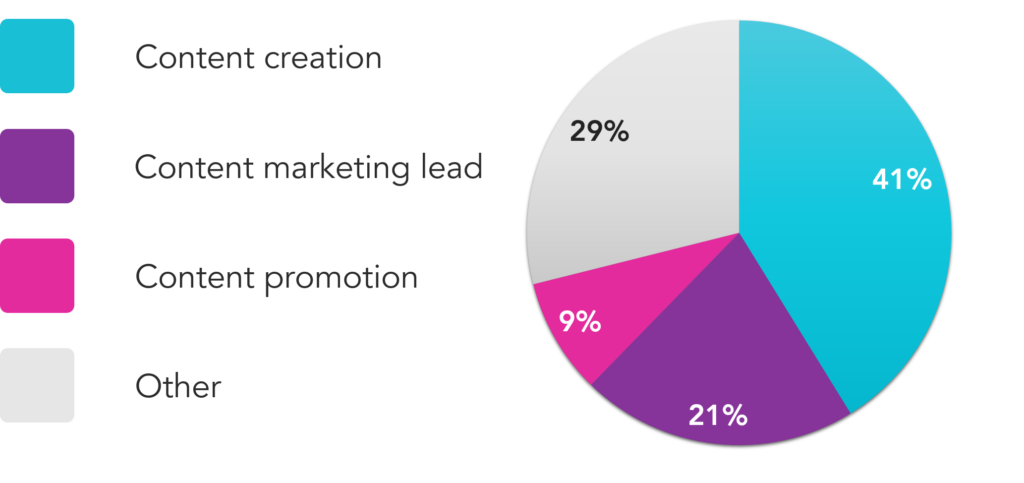
(Source: Curata – 2016 Content Marketing Staffing & Tactics Study)
No. 25: 64 percent of brands cited “how to build a scalable content strategy” as their greatest educational need.
(Source: Curata – 2016 Content Marketing Staffing & Tactics Study)
No. 26: Brands cited the bandwidth to create content as their greatest Content Marketing challenge (43 percent of respondents).
(Source: Widen Enterprises)
Content Marketing measurement
One of the most significant challenges brands face (so much so that we moved it into its own section) is measuring the effectiveness of Content Marketing campaigns. But, that’s not to say that many brands haven’t overcome this challenge.
No. 27: 43 percent of B2C marketers measure the ROI of their Content Marketing campaigns.
(Source: Content Marketing Institute – B2C Content Marketing)
No. 28: The top reason why B2C marketers don’t measure Content Marketing ROI is they “need an easier way to do this” (45 percent of respondents), followed by “no formal justification required” (34 percent) and “we don’t know how to do this” (26 percent).
(Source: Content Marketing Institute – B2C Content Marketing)
No. 29: For B2C marketers who measure Content Marketing results, 79 percent say they can demonstrate how those efforts have increased audience engagement, 65 percent can demonstrate how they’ve increased leads and 58 percent can show how they’ve increased sales.
(Source: Content Marketing Institute – B2C Content Marketing)

If you’re interested in implementing or improving your brand’s Content Marketing strategy, make sure to keep reading our Content Marketing series and subscribe to our blog for regular updates.
Download our guide to learn everything you need to know to launch effective Content Marketing campaigns.

![]()

![[Infographic]: Top 10 Reasons Why Your Brand Needs Content Marketing](https://mindstreammediagroup.com/wp-content/uploads/2018/02/Content-Marketing-Infographic-Header-Image.png)




